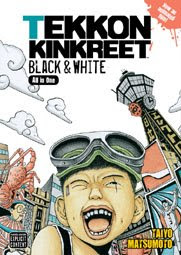 Manga Overview Manga OverviewBook Info Rating: Overall= B+ Story = B+ Art = B+ |
Journal
In Treasure Town, orphans Black and White rule the mean streets through violence and terror. These lost boys are direct opposites: Black being a streetwise punk who embodies everything wrong about the city, while White is a innocent dope, out of touch with the world around him. Together, they're unstoppable as they take on petty thugs, religious fanatics and brutal yakuza. But when a corporation called "Kiddy Kastle" tries to tear down and rebuild Treasure Town to fit its own goals, the boys must save the soul of their beloved city, that is if they can save themselves from inner demons. (Source: ANN)
I started reading the Tekkon Kinkreet manga because -- like so many other manga -- I had seen the animated movie and wanted to see how the original compared. And as visually and dramatically gripping as the movie is, I think the manga actually works much better due to the art style as well as the medium of manga itself.
The actual story of the manga is nearly identical to the movie: Two orphan boys -- Black and White -- living on the streets of a city call Treasure Town go up against a shady redevelopment group who want to build a theme park atop the decaying metropolis.
The story itself is solid and easy to follow with genuine characters and relatable drama. But even so there are plenty of qualities of the show that are pure fantasy -- like Black and White's ability to jump from the rooftops and land at street level unscathed, or the supernatural fighting abilities of Snake's assassin squad.
And certainly anime is a better medium to portray these kinds of fantastic elements than live action, since the stylized nature of anime keeps it one step removed from reality. But the medium of manga allows even more creative flexibility and potential for abstraction because it doesn't necessarily require the artist to maintain consistency between panels. In anime it would be odd and confusing to have seemingly random anthropomorphic animals and objects appear in the background, but the Tekkon Kindreet manga does so successfully and with minimal confusion or effect on the plot. And instead said random visuals add a sort of imaginative dreamlike quality to the story. That is especially important because it shows that despite the violence and torment that the story portrays, Black and White are still kids and still have that childish innocence. The anime certainly has lush and imaginative visuals, but lacks that dreamlike innocence from the manga.
But even though the art certainly makes for a more effective story, I think that most manga fans will pass this one by because the art is so nontraditional. It is more influenced by European abstract art (specifically French art from what I've read) than Japanese. But I think if you are open minded enough to try something a little different, this manga will be well worth the time invested.


No comments:
Post a Comment